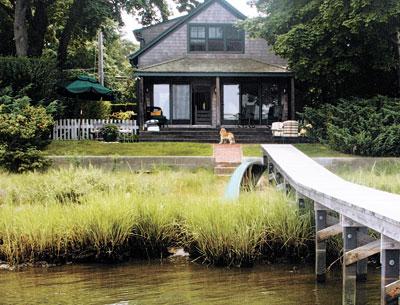HABITAT: An Updated, but Traditional, Summer Cottage

You don’t have to be some old salt with proud memories of swung fists and splintered pool cues at the Black Buoy to know that Sag Harbor was once a place with roughneck bars, little eateries run by annoyed cranks, a puzzling superfluity of gas stations, and the ragged glory of 19th-century manses fallen into decrepitude.
But here’s a question. Can a house embody the history, the resurrection, of a village? David Bray would say yes. Twice over.
In 1978, the Manhattan ad man turned real estate agent and his partner, Neal Hartman, bought an 1849 Greek Revival house on Henry Street in Sag Harbor Village for all of $47,000. “It was a wreck,” he said one afternoon late last month. “It had asbestos shingles, an asphalt roof. So we put a shingled roof on it. We put clapboarding on it, redid it, made it nice.”
“Those who started the trend of fixing up old houses are at fault for bringing New Yorkers here,” he said, reflecting on the familiar complaints about gentrification and stratospheric real estate prices, “but without them these places could not have stood up by themselves. They wouldn’t have lasted that much longer. And all the local tradesmen benefited.” What’s more, “the outskirts houses became worth more too.”
A fine example is on a 50-by-100-foot lot off Cove Road, a little cul-de-sac on Sag Harbor Cove. This is in Noyac, outside the village (which is evident now that Southampton Town has demarcated every hamlet with posted signs of civic pride).
“We bought it from the Fordham family about 27 years ago,” Mr. Bray said. He and Mr. Hartman would rent the Henry Street house and spend summers on the cove, inadvertently modeling their lives on the villagers of yesteryear who went by boat from Sag Harbor to their breezy, waterside cottages.
“I still call it the cottage, but it really was a cottage back then. No heat upstairs, the porch was enclosed — they weren’t thinking about water views back then.”
Built in 1929, the house has gone through three renovations since Mr. Bray bought it — for $65,000. The most recent work was completed roughly six years ago, about the time he and his partner sold the Henry Street house. They had bought a winter place in Key West in the 1980s, eventually becoming summer residents themselves.
Mr. Hartman, who died in 2010, was known in Sag Harbor for his work with the tree committee and for fund-raising efforts to save Christ Episcopal Church’s 1908 Meneely bell, a gift from the philanthropist Mrs. Russell Sage that he would ring after Sunday morning services.
Upstairs, one window looking onto the cove became three. There’s now an office on the second floor, a bedroom with a full bathroom, and a second bedroom with a half bath. What were once narrow stairs more suited to a tricky climb to an attic were rebuilt into an easily negotiated wraparound staircase with a landing.
Downstairs, the front door that opened into the kitchen was replaced with casement windows, and the main room now has an open layout where at one time it was divided into three small rooms. Mr. Bray also added a fireplace for the cool nights of early fall.
The house couldn’t be much closer to the water — from the brick patio it’s a stone’s throw away, a soft, underhand throw, at that. And it’s just steps through beach grass to a slim wooden dock. The boat was sold after Mr. Hartman died, but a canoe remains tucked under the planks. John and Elaine Steinbeck’s old place is across the way.
Sure, the lot’s small, he said, but then you’ve got the acreage of the cove as a backyard. “All that water and the sky above. We’ve got a couple of swans and four cygnets. An otter used to go back and forth right out there.” It had been a quiet summer, he reported, at least for boats and jellyfish.
Mr. Bray is tall and soft-spoken, with wavy gray hair that’s seen no thinning in his 70-plus years. He was an English major at Georgetown, and one of his treasures from that time is a copy of “Profiles in Courage” signed by John F. Kennedy. On the same shelves in the living room is a clock made from a miniature of the Old Whalers Church and a pink elephant watering can by the Sag Harbor illustrator James McMullan. A watercolor of Old Whalers by Whitney Hansen, another local artist, hangs on a nearby wall. Wicker and handmade wooden furnishings hark back to earlier times.
Summer was almost over. Soon Mr. Bray and his cocker spaniel, Emmett, would be heading south. “You draw sustenance from memories,” he said, surrounded by objects he loves, standing in a house still evocative of the man he chose to spend his life with.
Left, a green gateway to the Bray residence. Middle, woody accoutrements, an antiques picker’s dream. David Bray in his upstairs office with Emmett.
The open floor plan came courtesy of one of three renovations.
A nautical pillow — one of many living room decorations with a Sag Harbor theme.Homey examples of old-time needlework were collected by Neal Hartman over the years.Right, a snapshot from before work began.
Down the hall is a tucked-away bathroom. A kitchen window looks onto a front yard full of flowers.
Durell Godfrey Photos
